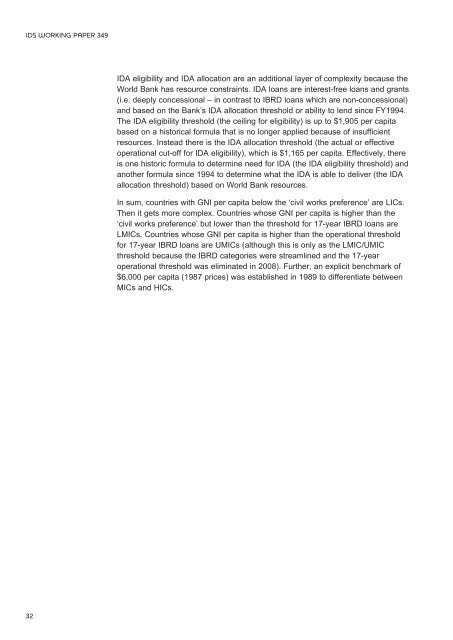Andy Sumner - Institute of Development Studies
Andy Sumner - Institute of Development Studies
Andy Sumner - Institute of Development Studies
Create successful ePaper yourself
Turn your PDF publications into a flip-book with our unique Google optimized e-Paper software.
IDS WORKING PAPER 349IDA eligibility and IDA allocation are an additional layer <strong>of</strong> complexity because theWorld Bank has resource constraints. IDA loans are interest-free loans and grants(i.e. deeply concessional – in contrast to IBRD loans which are non-concessional)and based on the Bank’s IDA allocation threshold or ability to lend since FY1994.The IDA eligibility threshold (the ceiling for eligibility) is up to $1,905 per capitabased on a historical formula that is no longer applied because <strong>of</strong> insufficientresources. Instead there is the IDA allocation threshold (the actual or effectiveoperational cut-<strong>of</strong>f for IDA eligibility), which is $1,165 per capita. Effectively, thereis one historic formula to determine need for IDA (the IDA eligibility threshold) andanother formula since 1994 to determine what the IDA is able to deliver (the IDAallocation threshold) based on World Bank resources.In sum, countries with GNI per capita below the ‘civil works preference’ are LICs.Then it gets more complex. Countries whose GNI per capita is higher than the‘civil works preference’ but lower than the threshold for 17-year IBRD loans areLMICs. Countries whose GNI per capita is higher than the operational thresholdfor 17-year IBRD loans are UMICs (although this is only as the LMIC/UMICthreshold because the IBRD categories were streamlined and the 17-yearoperational threshold was eliminated in 2008). Further, an explicit benchmark <strong>of</strong>$6,000 per capita (1987 prices) was established in 1989 to differentiate betweenMICs and HICs.32
















